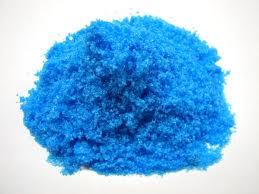Typically, the solution is heated to form a hot, saturated solution The heating allows for excess solvent to be removed via evaporation. As the hot saturated solution cools, the dissolved solid appears as crystals as the solubility of the solute decreases the decreasing temperatures. This means that as the temperature of the solution drops, less solute can be dissolved in the solution. The excess solute will then appear in the solution in the form of crystals.
Procedure:
1) Heat about 20cm3 of water in a beaker. Stop heating and remove from the tripod stand once bubbles are observed im the water to when the water boils.
2) Add one spatula of copper (II) sulphate into the hot water
3) Stir the mixture until all the copper (II) sulphate dissolves before adding another spatula of copper (II) sulphate.
4) Repeat step 3 until no more copper (II) sulphate can be dissolved.
5) Filter the solution if there are any solid impurities
6) Heat the copper (II) sulphate in an evaporating dish.
7) Stop heating when about half the solvent has evaporated from the solution. DO NOT HEAT TO DRYNESS.
8) Pour the solution into a clean small boiling tube and cool it in ice-cold water
9) Measure the time taken for crystals to appear
 |
| Copper(II) Sulphate |
 |
| Mixing the Copper(II) Sulphate into the hot water Filtering the mixture to get rid of solid impurities. Photo credits to Alanna Heating the evaporating dish Using rapid cooling on the mixture! |
Questions to consider:
1) How can you obtain more crystals from the cooled copper (II) sulphate solution?
-Add more water to dissolve the copper sulphate
-Gradual cooling instead of rapid cooling
2) Suggest 2 reasons why in crystallisation method we should stop heating before all the solvent evaporates
-Prevents decomposing of copper sulphate
-Soluble impurities will be left behind.



